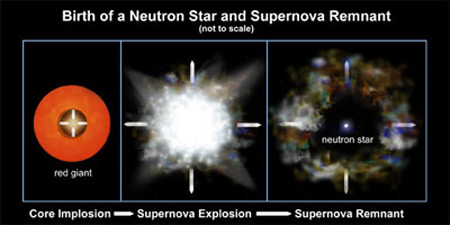These two supernova remnants are part of a new study from NASA's Chandra X-ray Observatory that shows how the shape of the remnant is connected to the way the progenitor star exploded. In this study, a team of researchers examined the shapes of 17 supernova remnants in both the Milky Way galaxy and a neighbor galaxy, the Large Magellanic Cloud.
The results revealed that one category of supernova explosion, known as "Type Ia," generated a very symmetric, circular remnant. This type of supernova is thought to be caused by a thermonuclear explosion of a white dwarf, and is often used by astronomers as a "standard candle" for measuring cosmic distances. The image in the right panel, the so-called Kepler supernova remnant, represents this type of supernova.
On the other hand, remnants tied to the "core collapse" family of supernova explosions were distinctly more asymmetric, which is seen in the morphology of the G292.0+1.8 remnant (left). The research team measured asymmetry in two ways: how spherical or elliptical the supernova remnant was and how much one side of the remnant mirrors its opposite side. In G292, the asymmetry is subtle but can be seen in elongated features defined by the brightest emission (colored white).
Out of the 17 supernova remnants sampled, ten were independently classified as the core-collapse variety, while the remaining seven of them were classified as Type Ia. One of these, a remnant known as SNR 0548-70.4, was a bit of an "oddball". This one was considered a Type Ia based on its chemical abundances, but has the asymmetry of a core-collapse remnant.
| Fast Facts for G292.0+1.8: |
| Credit |
NASA/CXC/UCSC/L. Lopez et al. |
| Release Date |
December 17, 2009 |
| Scale |
11.5 itsacross. |
| Category |
Supernovas & Supernova Remnants |
| Coordinates (J2000) |
RA 11h 24m 36.00s | Dec -59° 16' 00.00" |
| Constellation |
Centaurus |
| Observation Date |
6 observations between September - October 2006 |
| Observation Time |
144 hours |
| Obs. ID |
6677-6680, 8221, and 8447 |
| Instrument |
ACIS
|
| References | Lopez, L. et al, 2009 706 L106-L109; Park, S. et al, 2007, ApJ, 670 L121-L124 |
| Color Code |
Energy: Red (low energy); Orange (medium-low energy); Green (medium energy); Blue (high energy) |
| Distance Estimate |
About 20,000 light years |
|
| Fast Facts for Kepler's Supernova Remnant: |
| Credit |
NASA/CXC/UCSC/L. Lopez et al. |
| Release Date |
December 17, 2009 |
| Scale |
5 itsacross. |
| Category |
Supernovas & Supernova Remnants |
| Coordinates (J2000) |
RA 17h 30m 40.80s | Dec -21° 29' 11.00" |
| Constellation |
Ophiuchus |
| Observation Date |
6 observations between April - August 2006 |
| Observation Time |
208 hours |
| Obs. ID |
6714-18, 7366 |
| Instrument |
ACIS
|
| Also Known As | SN 1604, G004.5+06.8, V 843 Ophiuchi | | References | Lopez, L. et al, 2009 706 L106-L109; Park, S. et al, 2007, ApJ, 670 L121-L124 |
| Color Code |
Energy: Red (low energy);Yellow/Green (medium energy); Blue (high energy) |
| Distance Estimate |
About 13,000 light years |
|




Is there any expected difference in the remenant of a type 1a in the 2 main projenator scenarios Ie can you tell if the type 1a resulted from accretion from another star or from 2 white dwarfs merging
If not why not? Surely a merger would give a much less symmetric remnant.
Posted by Jon on Sunday, 11.23.14 @ 09:20am
Good and clear explanation. Easy to understand.
Posted by Amanda on Wednesday, 11.19.14 @ 08:30am
Marvelous job. Hats off to the scientists involved.
Posted by Souvik Biswas on Monday, 02.7.11 @ 00:17am
These pictures are amazing and they bring my attention to a whole new universe.
Posted by Meghan on Thursday, 03.4.10 @ 11:30am
The pictures are amazing.
Posted by lizette garcia on Thursday, 01.21.10 @ 17:28pm
This is very interesting, there is so much to see.
Posted by jenny on Thursday, 01.14.10 @ 10:57am
Excellent work, keep it up as the whole world benefits by learning how the universe works.
Posted by Barry Weseen on Sunday, 12.27.09 @ 16:18pm
Fabulous graphics and insights on an extraordinary event.
Posted by Dave on Saturday, 12.19.09 @ 19:10pm
Thanks so much. I have learned something new about Novas in general. It is so mind boggling, I get dizzy thinking about all this. There is so much to learn about this great universe we live in.
Posted by Marvin L. S. on Saturday, 12.19.09 @ 18:53pm
This is very nice. Good luck to the scientists. Give us more.
Posted by charles on Saturday, 12.19.09 @ 02:04am
More excellent images.
Very fine detail, and an elegant idea applied to great effect.
Posted by Mark Ballington on Friday, 12.18.09 @ 10:17am
Very good.
Posted by sicre on Friday, 12.18.09 @ 07:08am
Is there any indication of some vague gravitational wave behavior accompanied this discovery? Or it is too late to judge.
Posted by Magd Kahil on Thursday, 12.17.09 @ 23:34pm
Very informative article. As usual you continue to educate me in my interest in cosmology, although I remain a novice. Thank you
Posted by Rich on Thursday, 12.17.09 @ 18:16pm
Cool
Posted by DAVID on Thursday, 12.17.09 @ 17:23pm